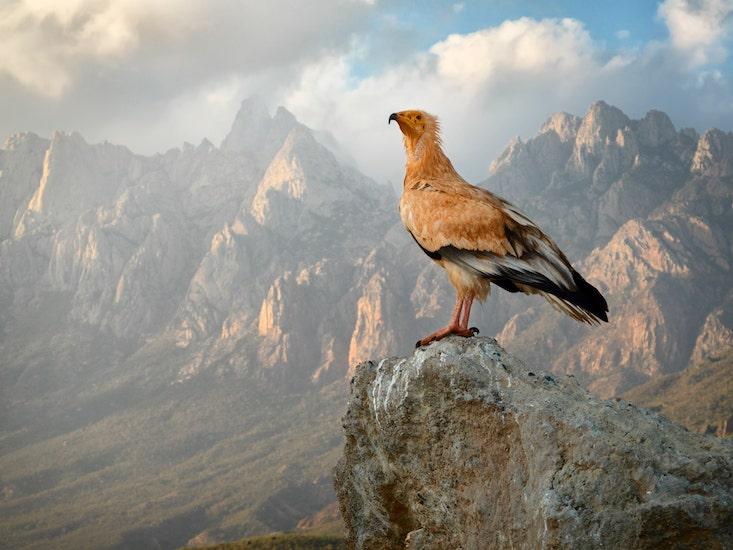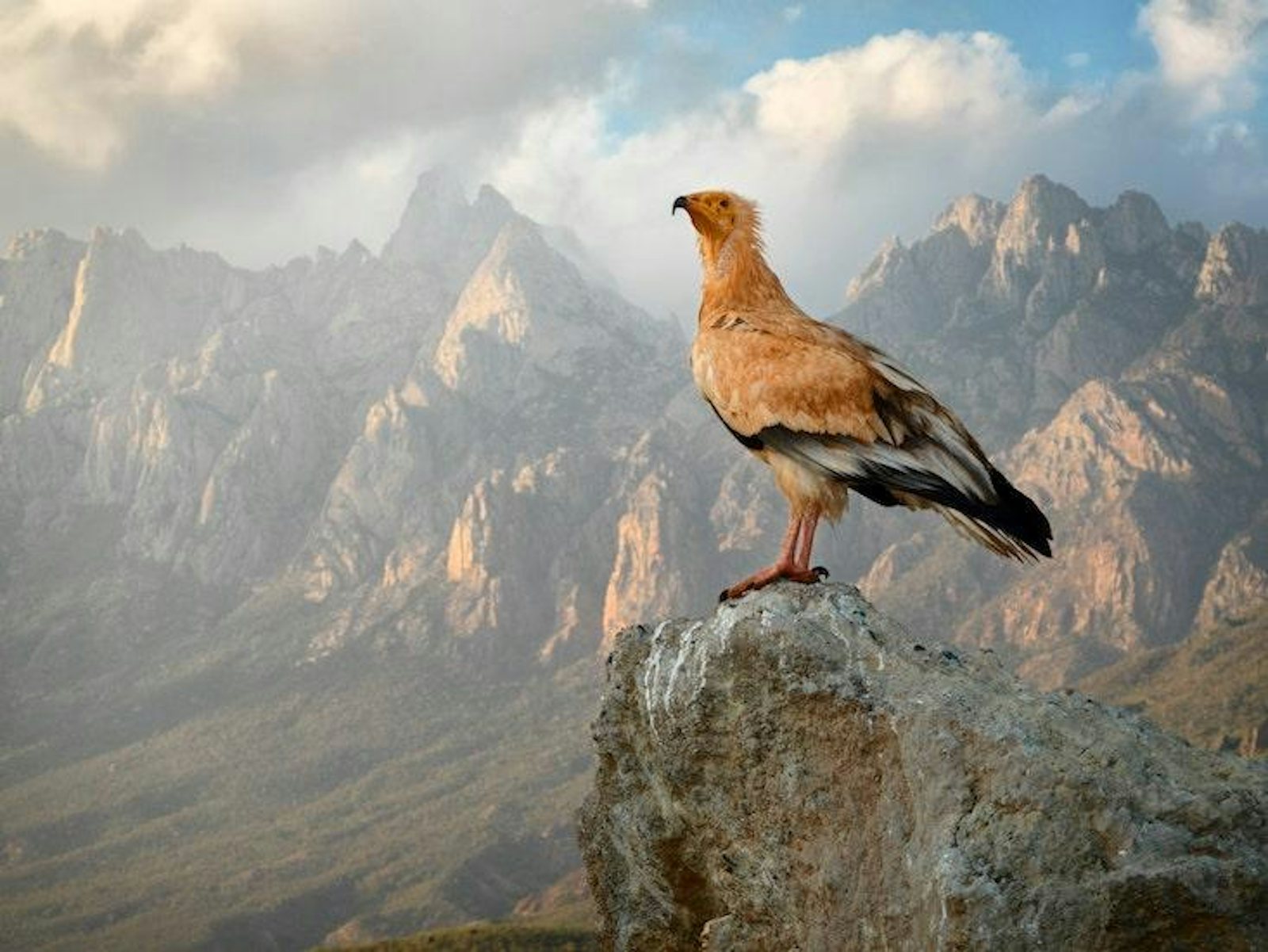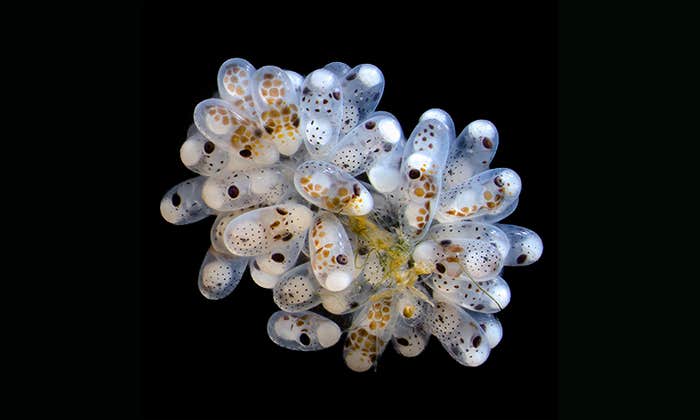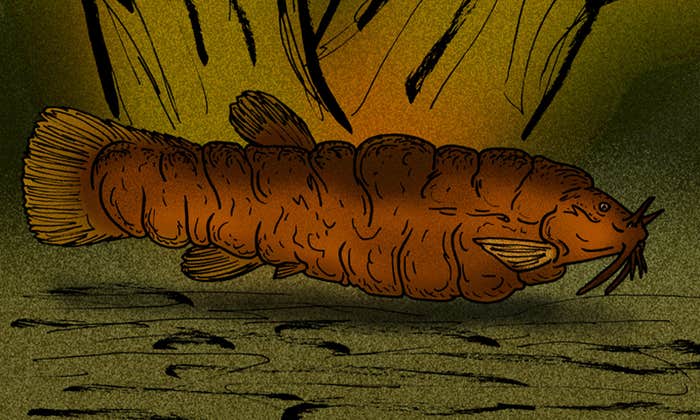
On a bright March morning as wildlife photographer Oriol Alamany tucked into breakfast on the island of Socotra, an Egyptian vulture landed on a nearby rock. Caught without proper equipment, Alamany crawled across the ground to photograph the bird from below at close range with a small camera he kept in his pocket. The vulture stood its ground. The species, Neophron percnopterus, is known for its tolerance of people and its abundance on this exceptionally biodiverse island, a mountainous flake of Yemen at the mouth of the Gulf of Aden that has been called the Galápagos of the Indian Ocean. Egyptian vultures line walls and dumps around the towns of Hadiboh and Qalansiya; they alert shepherds to births and deaths among their flocks; they congregate around wedding celebrations and picnics and, as Alamany discovered, are more than happy to join a traveler in his repast.
The birds’ appetite for rich human cast-offs isn’t the only sign of their intelligence. They’re also one of the few bird species that have been observed using tools, dropping rocks on eggs belonging to other large birds in an effort to score a tasty, fresh meal. The specific targets of these assaults—the eggs of ostriches, pelicans, and flamingoes among them—depends on the location within the vultures’ considerable range, which stretches across three continents. Egyptian vultures also gather wool by winding it with sticks to fluff up their reeking nests, which may include fish bones, animal skins, and human feces among their branchy tangle.
The birds play an outsized role in local waste disposal.
Poop isn’t just structural; it’s culinary, too. The birds’ coprophagia may help give their naked faces their striking yellow color. Some consider the Egyptian vulture to be the most beautiful among vulture species because of this and their striking plumage. Their wings are mostly white, bordered with long, sleek feathers of jet black. And the plumage on their heads, necks, backs, and breasts are stained gold to orange by the iron found in the red soils of the arid habitats they favor. On Socotra, in particular, the vultures are flame bright.
That Egyptian vultures are so ubiquitous on the island, numbering 1,900 or 2,560, depending on the source consulted, is a bright spot in an otherwise grim conservation story. The International Union for Conservation of Nature declared the species globally endangered in 2007, due largely to a sudden decline in India, where the birds have been poisoned by livestock carcasses laced with the veterinary anti-inflammatory drug diclofenac. Longer-term declines have also taken their toll in Europe, due to waste control and intentional poisoning, and Africa, due to a loss of large wild ungulates, among a slew of other factors.
Researchers R.F. Porter and Ahmed Saeed Suleiman suggest that Socotra’s anomalously healthy population may have benefited from a lack of feral dogs and pesticides in local farming, and the absence of diclofenac on the island, as well as abundant caves and sheltered ledges among the cliffs, rock outcrops, and mountains for nesting. Perhaps most important, according to a study published in 2013 by biologist Laura Gangoso and colleagues, is that a reciprocal relationship still exists between people and vultures here, helping make the population one of the densest in the world. Their abundance on the island probably first arose from settlers’ introduction of large livestock some 3,000 years ago, and even now, the birds play an outsized role in local waste disposal, eliminating between 16.6 and 22.4 percent of decaying organic waste produced on the island each year, from carcasses to feces. The Socotri teach their children to respect the birds, tell stories and jokes in which they feature, and refer to them lovingly as soeydu—literally, “garbage bin.”
Sarah Gilman is a writer, illustrator, and editor who covers the environment, science, and place from rural Washington state. She’s also a contributing editor at Hakai Magazine. Her work has appeared in The Atlantic, Audubon, Smithsonian, High Country News, National Geographic, and others.
Oriol Alamany is a nature, conservation, and travel photographer from Spain, with a degree in Graphic Design. His photography mainly focuses on endangered species, such as the snow leopard, the Pyrenean brown bear, or the Balearic shearwater. He also covers the wider natural world and cultural heritage of remote areas of the planet. He is the author of numerous books and his work has been published in National Geographic-Spain, BBC Wildlife, Terre Sauvage, and many more publications.
The image and text originally appeared on bioGraphic, an online magazine about science and sustainability.























